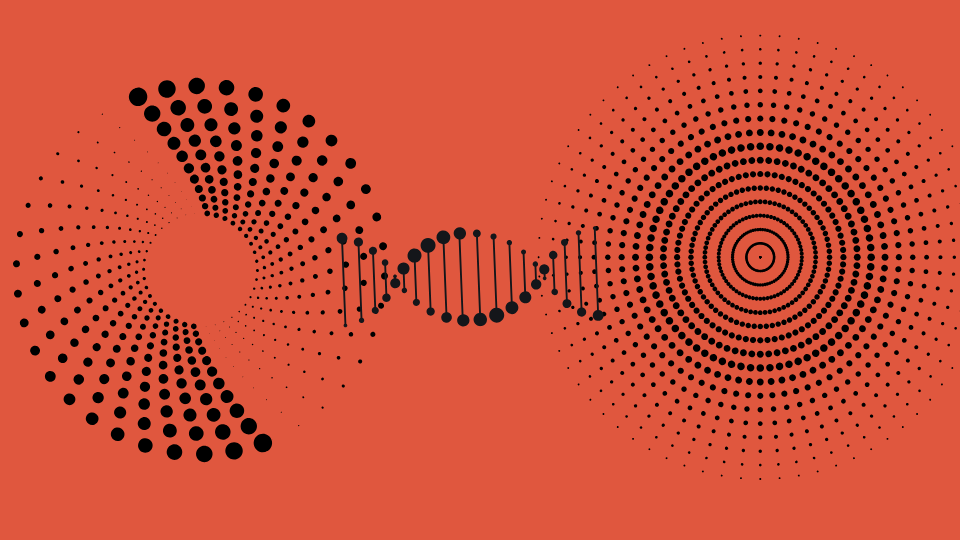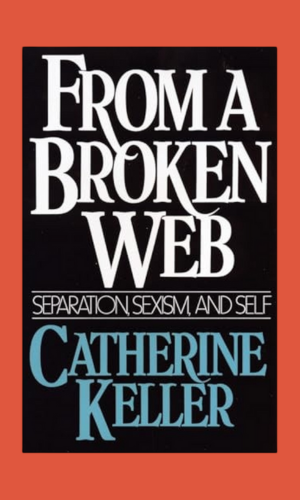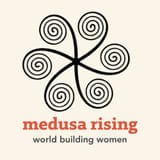Interwoven Selves: Review of From a Broken Web | by Therese Doherty
We need "to spin a meaning of self out of our femaleness, without reducing it to anything exclusively 'feminine'”.

Catherine Keller, From a Broken Web: Separation, Sexism and Self, (Beacon Press: Boston, 1986).
We arise from the matrix; we redesign its elements; we are woven back into the matrix. This is the religious act of reconnecting. As the word itself tells us, matrix is always mater, mother. (p. 248)
Catherine Keller begins From a Broken Web with a compelling thesis: that ‘separation and sexism have functioned together as the most fundamental self-shaping assumptions of our culture’ (p. 2). From this she weaves an extraordinary exploratory map of the territory of connection and self-definition within and then beyond patriarchal scripts, and how we can form a new model of self-shaping for women, and men. When there is sex-denial on the left, and the straightjacket of femininity on the right, this project seems of particular importance, for to escape from patriarchal gender and all of its destructive consequences means that ‘we must become psychosocially conscious of its causes as they operate deep within ourselves, where we internalize vast, impersonal social patterns’ (p. 95).
Keller defines the patriarchal split selves as the (mostly male) separative self and the (mostly female) soluble self; the former making ‘itself the absolute in that it absolves itself from relation’, while the latter ‘dissolves into relation’ (p. 26). In other words, ‘the soluble woman has embodied connection without self, while the separative male has incarnated self without connection’ (my emphasis; p. 206). This male selfhood, gained at the expense of women’s, is derived from the myth of the hero-warrior who armours himself against the world and his own depths, constantly roaming on adventures, while women wait patiently and dependently, like Penelope, for his return.
Keller reveals in her inquiry into psychoanalysis and process philosophy that ‘as women sense, all reality is interconnected’ (p. 189), and most crucially, that the so-called ‘oceanic feeling’ of early childhood is not a state that must be left behind (as in normative male socialisation), but the natural condition that forms the ground of being for all human development: ‘Relatedness is the a priori. Disempathy and separation, not connection, are what must be explained’; and ‘the female connection to mother and world preserves the oceanic feeling of an empathic continuum initially common to both sexes’ (p. 136). This is the starting place for everyone.
The self-structure of separation is a patriarchal artifice … connection is not so much forced upon females as simply left to turn in on itself in the isolation within the narrow range of relations traditionally open to women. The web is not originally a trap. (p. 137)
Within this web of complex interconnection the self could develop along nonsexist lines, unfolding inside a reality of ‘primal empathy’ (p. 184) in which we differentiate interdependently with the influence of others and world. Process thought shows us that we are events or processes, rather than fixed substances, ‘both radically spontaneous and deeply continuous’ (p. 195). This means that ‘the connected, permeable ego ascribed to female children fits the description of an actual entity … much more nearly than does the rigid and clearly delineated male ego’ (p. 189). And because we usually remain closer to that connected, permeable base, girls and women can model the transformation that must occur for both women and men to achieve postpatriarchal human selfhood.

As Keller states, ‘Feminist theory, like all theory, is theoria, “seeing,” that is, vision’ (p. 157), and via a ‘metaphysical feminism’ that takes all interrelations into account, from sex to race, politics to ecology, childhood to elderhood, we can examine not just what we see, but how we see it. Because we recognise that ‘male dominance [is] a social structure of oppression as well as a psychological complex’ that runs deep within us all (p. 118), to neglect the ‘polyscopic discernment’ (p. 250) that could lead us to knowledge and right action, would leave the system of disconnection intact and change nothing. For if we are to become more than just deficient, monstrous females, and disconnected, armoured men, we need to move far beyond the kind of socialisation that currently exists. We need ‘to spin a meaning of self out of our femaleness, without reducing it to anything exclusively “feminine”’, while males need to be challenged to embrace ‘modes of relatedness that require not the sacrifice of their maleness but of their ego rigidities and corollary manipulation of women’ (p. 161). Namely, ‘Women do not need to harden but to strengthen; men need … to melt down the hardness of the heart’ (p. 212). Easier said than done, perhaps, but it’s a start.
Having revealed and re-membered this differentiated yet connected self, Keller concludes with the idea of an arachnean spirituality, making use of the metaphors of the spider and her web, and of the oceanic mother Tiamat—the first reaching wide, the second deep. ‘In their different dimensions and domains, both horrify the self-forgetting fixity of other-opposed egos’ (p. 249). In this both/and creation we can also find the both/andness in ourselves, of body intertwined with mind/soul:
I encounter the world only as embodied. Through my bodiliness I come to the animating knowledge that the energy of matter and the energy of soul are at base indistinguishable. Soul matters (p. 236).
Female embodiment, with its cycles and procreative possibilities, ‘bind[s] us to no stereotype … That women are built of a complex architecture of openings and enclosure need not lock us into domestic “inner space,” vulnerability needing male protection’ (p. 239). With our ensouled bodies, our embodied souls, and with the female power we find in the oceanic depths and the immense webbed intersections of reality, we can think ‘connectingly’ (p. 160) and create ‘a theory of the interrelatedness of all subjective life’ (p. 149). This is just the kind of revolutionary thought that we need.
Keller explores psychoanalysis, philosophy, myth and theology, disclosing the understandings that are of use, but also pointing out the sexism and androcentrism often inherent in these fields, which is hugely useful for feminist analysis. My only real criticism is that this book is so challenging that it’s likely impenetrable for the average reader, meaning that its insights are trapped within its pages, unable to diffuse out into wider consciousness. Though in the almost four decades since its publication much has changed in terms of how we view ourselves, ecologically and spiritually, philosophically and psychologically. We know (or are at least remembering) that we are interwoven with each other and the more-than-human, just as body is entangled with mind/soul. Women’s spirituality has enabled us to understand reality via the integration of opposites, rather than any kind of divisive dualistic system, for Life is the all-encompassing yet multiple matrix, which ‘implicitly mothers’ (p. 222).
Yet in a world that is becoming more socially and politically divisive, maybe a return to Keller’s thesis is now apt, not just to counter the new problems of separation, but to add the analysis of sexism that other understandings still lack. While women and men are surely different, the differences between us would likely be much less stark in the absence of gendered socialisation, which splits us off from each other and limits our potentials, endangering our future as a species, while causing us all so much misery. From a Broken Web is worth making the effort to read for that reason alone. Failing that, perhaps we should all just turn to ‘the primary antidote today to the soluble feminine (non)self’ (p. 210) and read some Mary Daly.
Therese Doherty lives with chronic illness and occasionally writes and makes art, but mostly just reads a lot. She can be found here: @offeringsfromthewellspring.
Maybe this post moved you? Would you like to dedicate it in the name of an ancestor, sister, sister-friend, lover, daughter? Use Eopsin's Ward to have your dedication added here.
Add your voice to this Gorgon chorous? Visit Contribute.




